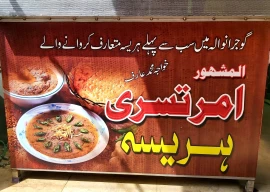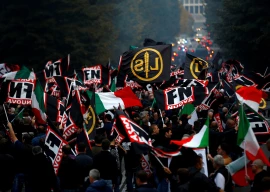

The London Fashion Week took place from September 12 to September 16 this year. PHOTO COURTESY: AFP
This year I had the privilege of attending the London Fashion Week (LFW) for the first time, which made me realise how relatively simple things are for fashion journalists in Pakistan. At home, there is one PR company that usually deals with all the invites and as a member of the press, you need one pass to get into all the required areas. All the events are held at the same venue, where each day up to eight designers showcase their work on the same ramp. Hence, it was a real shock for me to see how differently things were done in London. Firstly, you have to be an accredited member of the press, or a blogger, photographer, buyer or designer to be able to register. Socialites, celebrities and students are dealt with separately. After filling out numerous forms, preparing my portfolio and getting my publication to send letters stating I was a journalist, I finally got accredited only to find out that in order to attend different shows one had to apply directly to each design house (there were around 85 designers participating in LFW this year) and request them for invites. After drafting numerous emails outlining details about my work and publication and my reasons for attending their particular shows, I waited patiently to hear back. Luckily, invites started pouring in, and my excitement started to mount.
Who wore it best?

A bag from the Anya Hindmarch spring/summer 2015 collection. PHOTO COURTESY: LFW
Somerset House is the home of LFW. This neoclassical building turns into a real live fashion jungle for five days where one can spot countless designers, bloggers, journalists, buyers and photographers prowling around eyeing the season’s best (and worst) catches. While Somerset House is ground zero, most of the shows you will actually end up attending are all across the city at various hotels, galleries and design house studios. The general buzz of excitement around the area and the sound of stilettos ‘click clacking’ on the pavement is enough to get your adrenaline pumping. But make sure to wear comfortable footwear as your arms and legs might give up from all the moving around.

What is worn on the streets during international fashion weeks is as important as what is showcased on the ramp. PHOTO COURTESY: LFW
After registering and getting your pass attached to a lanyard, the entire Somerset House opens up to you. There is a specific press and buyers lounge where you can go to recharge your phones and plug in your laptop to blog, tweet and instagram live from the event.

In Pakistan, fashion weeks have specific red carpet timings, during which attendees put their best foot forward and flaunt their latest accessories and wardrobe acquisitions. Fashion weeks abroad on the contrary have become all about street style, creativity and making a statement. Your personal style is what gets recognised on the streets of London and there are enough photographers mulling around to capture it through their vigilant lens. But being plain pretty is not good enough to get noticed — your outfits have to be edgy, well thought out and, in some cases, so outlandish and bizarre that they catch people’s attention.

Models present the Burberry Prorsum 2013 spring/summer collection at London Fashion Week. PHOTO COURTESY: AFP
Let the action begin
I ended up seeing seven designers’ collections, including Jean-Pierre Braganza and Paul Costello’s ramp shows and Markus Lupfer’s showcase. Since every designer is responsible for their own show, each show has a specific theme that represents the mood of the collection. Everything, from hair and makeup to the choice of venue and the type of runway, depends not only on the collection but also on the design house’s budget. The Somerset House courtyard has a catwalk enclosure that is used by multiple designers throughout the week to show their collections.

Costello showcased his whimsical collection at Simpson at the Strand, a quaint hotel close to Somerset House. The Victorian feel of the banquet hall used as the runway tied in well with the concept of the collection. Markus Lupfer utilised the Diary Art Centre in Russell Square for his sporty chic collection. He injected the punky playfulness of his collection with hi-tech holographics in lilac and lime for sharp party dresses. What was interesting about the display was the interactive nature of the showcase. The scene was set to feel like a beach and the attendees sipped on pina coladas as they moved around to see the collection. Rather than strutting down the runway, the models were relaxed and interacting with each other and acknowledging the photographers as they posed for them.

At international fashion weeks, however, who comes to watch your show is far more important than what the show is about. Hence, every designer is hustling for major publications, editors, fashionistas, photographers, top bloggers and buyers to be in attendance, since they have the power to dictate the future of the brand to a certain extent.
Show, don’t tell
Within the walls of the massive façade of Somerset House is where the actual business takes place. A number of clothing, accessories and shoe designers that do not have ramp shows use these showroom stalls to exhibit their collections. Attendees with access to these spaces can meet the designers or their PR companies to get a better feel of their collection for the upcoming season. Buyers from across the world can also view and select what they want in their particular stores, boutiques and websites.

Designers that do not have ramp shows have dedicated stalls to display their collections. PHOTO COURTESY: LFW
From established designers to emerging talent, everyone has their specific space and it was an eye opener for me to see how methodical everything was. Each PR company was designated a particular room where the designers they represented showcased their work. It made me wonder how Pakistani designers would fare if they strengthened their production ends and created collections that could be showcased at a particular venue instead of just doing ramp shows. The entire experience also helped me understand the basic philosophy behind fashions weeks — to promote all kinds of work being created from high-end fashion houses to mid-tier designers that have been creating some fantastic collections being stocked around the world. While each fashion week, be it London, New York, Paris or Milan, focuses primarily on designers hailing from that particular country, they also have a quota for international merchandisers displaying their work.
Takeaways
The grass always appears greener on the other side but even well-established platforms, such as LFW, have a few loose ends. This time, it was due to the different kinds of invites that were sent out to guests. First are guests with seated invites, allowed into the venue before everyone, followed by standing invites and lastly guests with e-vites, who are called in if there is any space left. But due to the excessive invites sent out, far beyond the capacity of the venue, a lot of people who had trekked across towns to see a show were turned away at the last minute.

A glimpse from the Lulu & Co 2015 spring/summer collection. PHTOT COURTESY: LFW
The immense focus on business throughout LFW, however, was an eye-opener. Each designer displayed their collection not just with the intention of showcasing what they had created but also with the intention of selling to mega conglomerates and boutiques situated all across the world. The discipline, time management and efficiency with which LFW operated was also awe-inspiring.
Even though it is impossible to draw parallels between LFW and local fashion weeks at this point due to the vast difference in magnitude, experience and resources, I couldn’t help but wish for our industry to graduate to a level where each design house is able to host its own show during fashion week too.
QUICK ROUND-UP FOR LONDON FASHION WEEK SPRING/SUMMER 2015
Number of days: 5
Number of presentations: 24
Number of catwalk shows: 58
Momina Sibtain is a fashion and lifestyle correspondent for The Express Tribune. She tweets @MominaSibtain
Published in The Express Tribune, Sunday Magazine, October 12th, 2014.


















COMMENTS
Comments are moderated and generally will be posted if they are on-topic and not abusive.
For more information, please see our Comments FAQ